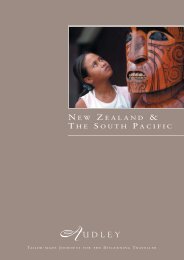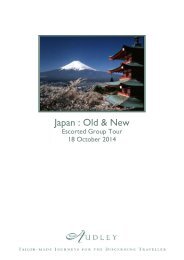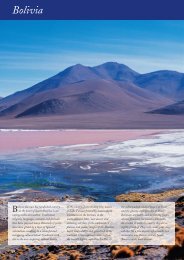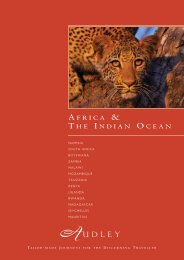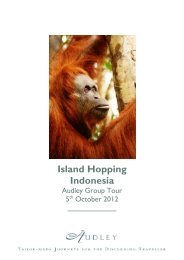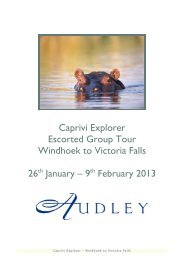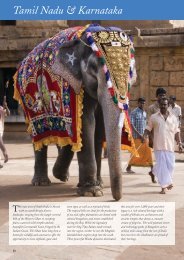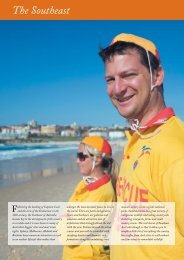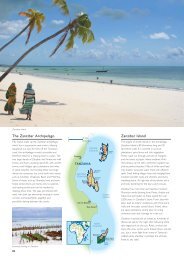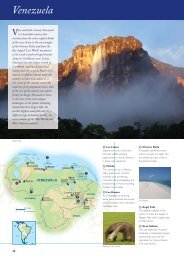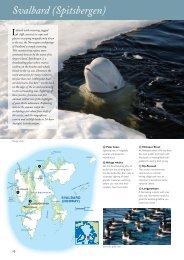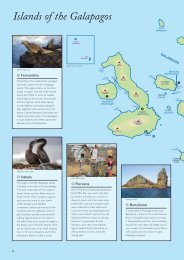Download - Audley Travel
Download - Audley Travel
Download - Audley Travel
You also want an ePaper? Increase the reach of your titles
YUMPU automatically turns print PDFs into web optimized ePapers that Google loves.
A friendly First Nations greeting<br />
History<br />
Canada and Alaska’s first inhabitants were native<br />
Americans, thought to have arrived across ice<br />
bridges over the Bering Strait from Eurasia many<br />
thousands of years ago. There is also evidence of<br />
Viking settlement, but it was the arrival of the<br />
Europeans, most notably the French and British,<br />
searching for whale-oil and furs in the 16th and<br />
17th centuries, that forced the rate of change.<br />
The French colony, known as ‘New France’, was<br />
officially ceded to the British in 1763 and the<br />
country that is now Canada was formed in 1867<br />
by the confederation of four British North<br />
American colonies. In the early days it was<br />
Canada’s natural resources, its furs from the<br />
hinterland and fish from the sea, that laid the<br />
foundations of its wealth, but as the second largest<br />
country in the world it is perhaps unsurprising that<br />
other assets were just waiting to be uncovered.<br />
Canada and Alaska struck the headlines with the<br />
discovery of gold in the Klondike and substantial<br />
oil deposits were later to be found. Over the<br />
years Canada has gained independence from the<br />
UK but is still a constitutional monarchy with<br />
Queen Elizabeth II as Head of State. With small<br />
populations spread thinly over a huge landscape<br />
both Canada and Alaska remain pioneer<br />
destinations - independently minded and forward<br />
looking, and as any visitor will attest, many parts<br />
still feel barely explored: truly a new world.<br />
First Nations<br />
There are approximately one million First Nations<br />
Canadians today. This includes 200,000 Métis<br />
(aboriginal and French mixed race) and 50,000 Inuit.<br />
Their origins stem from the end of the last Ice Age,<br />
about 20,000 years ago, when nomadic tribes<br />
followed herds of mammoth and bison across the<br />
land bridge joining Siberia and Alaska. The people<br />
were misnamed firstly as ‘Indians’ by 16th century<br />
Spanish traders who mistakenly believed that they<br />
had reached India, and later ‘Red’ by the British who<br />
encountered Newfoundland’s Beothuks smeared in<br />
red ochre to repel insects. The natives of the<br />
extreme north were named ‘Eskimos’ which<br />
translates as ‘eaters of raw meat’. Unsurprisingly<br />
these names have been rejected by the aboriginal<br />
peoples in favour of ‘First Nations’ and, in the north,<br />
‘Inuit’ meaning ‘the people’. Visitors today can<br />
experience a resurgent First Nations culture<br />
including the abandoned seaboard villages and totem<br />
poles of British Columbia, archaeological heritage<br />
sites in Alberta and Saskatchewan, modern day<br />
‘pow-wows’ (singing, dancing, storytelling) in Ontario<br />
and Inuit communities in the north of the country.<br />
Accommodation<br />
The range of accommodation in Canada and Alaska<br />
is as diverse as the landscape itself. In the big cities<br />
you can stay in stylish boutique properties, often in<br />
restored historic buildings, luxury hotels with<br />
magnificent views or delightful bed and breakfasts<br />
tucked away from the hustle and bustle. In rural areas<br />
there are charming log cabins, often overlooking<br />
wilderness lakes, whilst ranch stays offer a chance<br />
to live the life of a cowboy. All the accommodation<br />
options detailed in this brochure have been carefully<br />
selected to offer you a range of alternatives but some<br />
of our favourite properties, for reasons of space, are<br />
not detailed in the following pages. Please call to<br />
discuss your requirements with our Canada and<br />
Alaska specialists: they have visited a huge range of<br />
properties and will have more suggestions to match<br />
your preferences and budget. Wherever you stay,<br />
friendly North American hospitality is bound<br />
to ensure your stay is a memorable one.<br />
Food & Drink<br />
In an area as large as Canada and Alaska the cuisine<br />
varies widely from region to region. Cities are hugely<br />
cosmopolitan, with all the cuisines of the world<br />
represented in urban centres such as Montréal with<br />
plenty of restaurants putting a North American twist<br />
on their Gallic heritage. The west coast has<br />
developed its own Pacific Rim fusion cuisine, while<br />
the Atlantic regions have access to some of the<br />
world’s freshest and largest lobsters amongst a<br />
wealth of other seafood. Inland, meals are more<br />
likely to be made up of locally-raised meats, with<br />
barbeques and steaks a traditional favourite: servings<br />
are often huge and North American breakfasts can<br />
be a real highlight of your stay.<br />
4



